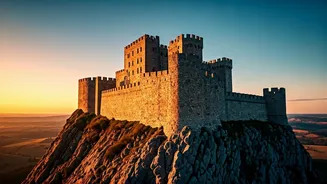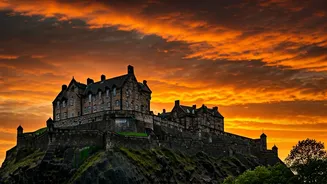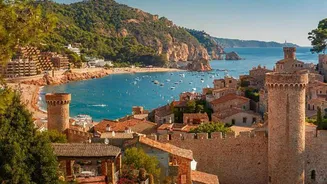Himeji Castle, Japan
Himeji Castle, often called the 'White Heron Castle' due to its elegant white exterior, stands as a testament to Japan's rich history. Construction began
in 1333, and it was significantly expanded in the 17th century. The castle's complex design, including defensive features like interlocking gates and winding paths, reflects the strategic thinking of the samurai era. Visitors are struck by the intricate architecture and the cultural heritage embodied within its walls. The castle's enduring presence is symbolic of Japan's resilience and its deep connection to its past. During historical events, the castle played a vital role, acting as a stronghold and a symbol of power. Its beauty has been preserved, making it a popular destination for tourists from around the globe. Himeji Castle continues to captivate visitors with its beauty and historical significance.
Alhambra, Spain
The Alhambra in Granada, Spain, is a majestic palace and fortress complex that showcases the height of Moorish art and architecture. Its construction began in the 13th century and was continually expanded and refined over several centuries. The Alhambra is celebrated for its stunning courtyards, intricate tilework, and delicate stucco carvings. Key features include the Court of the Lions, with its iconic fountain, and the Hall of the Ambassadors, which exemplifies the luxury of the Nasrid dynasty. It served as a royal residence and a symbol of Islamic rule in the Iberian Peninsula. The Alhambra's survival is credited to its unique design and robust construction. The Alhambra continues to attract tourists who appreciate history and exquisite craftsmanship. The Alhambra stands as a symbol of cultural exchange, blending Moorish artistic traditions with European influences.
Château de Chambord, France
Château de Chambord, situated in the Loire Valley, is one of the most recognizable castles in France. Commissioned by King Francis I, the construction started in 1519. The castle is celebrated for its distinctive French Renaissance architecture and intricate design. Its most striking feature is its double-helix staircase, attributed to Leonardo da Vinci. It was intended as a hunting lodge, reflecting the royal court’s love for outdoor pursuits. Chambord's vast scale and elegant design made it a symbol of royal power and wealth. Its survival highlights the French monarchy's legacy and its dedication to arts and architecture. Visiting Chambord offers a fascinating insight into the grandeur of the French Renaissance. Its extensive grounds and architectural details make Chambord a captivating destination.
Edinburgh Castle, Scotland
Edinburgh Castle dominates the skyline of Scotland's capital city, perched atop an extinct volcano. This historic fortress has a history dating back to the 12th century, with significant additions and expansions throughout the centuries. It served as a military base, a royal residence, and a prison, playing a crucial role in Scotland’s history. Key attractions within the castle include the Crown Jewels, the Stone of Scone, and the Great Hall. The castle’s strategic position allowed for control of the surrounding area. Edinburgh Castle is a key symbol of Scottish identity and resilience. Its well-preserved structures and museum displays attract visitors interested in Scottish history. The castle’s role in various sieges and battles reflects Scotland's struggle for independence.
Neuschwanstein Castle, Germany
Neuschwanstein Castle in Bavaria, Germany, stands out for its romantic fairy-tale appearance. Constructed in the 19th century under King Ludwig II, the castle's design was inspired by the operas of Richard Wagner. Its unique architecture is a fusion of Romanesque and Gothic styles. It was never intended as a defensive fortress, but as a personal retreat for the king. Key features include opulent interiors and stunning views of the Bavarian Alps. Neuschwanstein stands as a monument to Ludwig II's artistic passions and his dream of an idyllic retreat. Its survival involved careful planning and meticulous craftsmanship. The castle has become one of Germany’s most visited attractions. Neuschwanstein remains a symbol of romanticism and a source of inspiration for many.
Bran Castle, Romania
Bran Castle in Romania, often associated with the legend of Dracula, is a medieval fortress steeped in history. Its construction dates back to the 14th century, initially built to defend the border of Transylvania. The castle's imposing design includes narrow passages, strategic courtyards, and towers, reflecting its defensive purpose. While its association with Vlad the Impaler is debated, the castle’s mystique continues to draw visitors from all over the world. Key features include its strategic location and distinctive architecture. Bran Castle's survival has been marked by its ability to adapt and serve different purposes over the centuries. Its link to the Dracula legend enhances its allure, making it a major tourist destination. Bran Castle provides a captivating glimpse into Transylvanian history.











